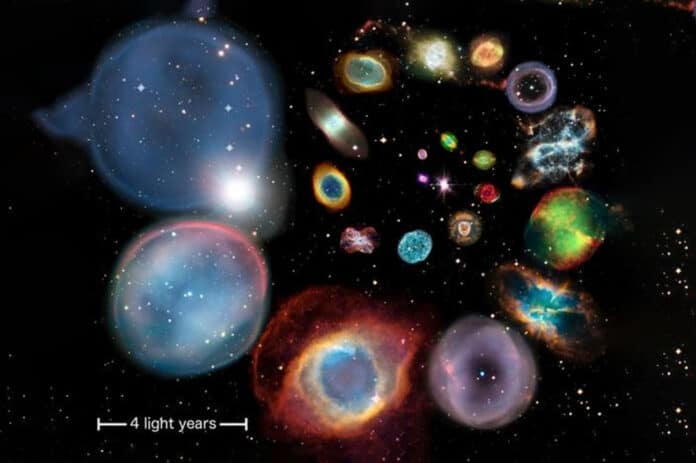Planetary nebulae are clouds of gas expelled by stars at the end of their lives. The ejected clouds are ‘ghosts’ of their dying stars, forming beautiful structures such as an hourglass or butterfly shape.
Almost a decade ago, Manchester PhD student Bryan Rees discovered the alignment of planetary nebulae. However, it remained unexplained.
A collaboration of scientists from The University of Manchester and the University of Hong Kong have found a source for the mysterious alignment of stars near the Galactic Centre. Along with confirming the alignment, scientists found a particular group of leads that is responsible, namely close binary stars.
Scientists investigated a collection of so-called planetary nebulae in the Galactic Bulge, close to the Milky Way‘s center. These nebulae are unrelated, originate from distinct stars, were born at various times, and live their entire lives in multiple locations. However, the study discovered that many of these shapes align nearly parallel to the galactic plane (our Milky Way) in the sky and similar patterns.
This is in the same direction as found by Bryan Rees a decade ago.
The alignment is only present in planetary nebulae with a close star companion, according to the latest study directed by University of Hong Kong student Shuyu Tan. A tighter orbit than Mercury has to the Sun is taken by the companion star around the primary star at the planetary nebula’s center.
The alignment is not present in the planetary nebulae that do not exhibit near partners, which suggests that the alignment may be related to the initial separation of the binary components during the star’s formation.
Albert Zijlstra, co-author and Professor in Astrophysics at The University of Manchester, said: “This finding pushes us closer to understanding the cause for this mysterious alignment.”
“Planetary nebulae offer us a window into the heart of our galaxy, and this insight deepens our understanding of the dynamics and evolution of the Milky Way’s bulge region.”
“The formation of stars in the bulge of our galaxy is a complex process that involves various factors such as gravity, turbulence, and magnetic fields. Until now, we have lacked evidence for which of these mechanisms could be causing this process to happen and generating this alignment.”
“The significance of this research lies in the fact that we now know that the alignment is observed in this specific subset of planetary nebulae.”
Using the European Southern Observatory Very Large Telescope, the researchers examined 136 confirmed planetary nebulae in the galaxy bulge, the thickest region of our Milky Way of stars, gas, and dust.
Forty of these from the initial study were re-examined and measured using photos from the high-resolution Hubble Space Telescope.
Prof Quentin Parker, the corresponding author from the University of Hong Kong, suggests the nebulae may be shaped by the rapid orbital motion of the companion star, which may even end up orbiting inside the central star.
The alignment of the nebulae may mean that the close binary system preferentially forms with its orbits in the same plane.
In future studies, scientists will focus on understanding the mechanisms behind the alignment.
Journal Reference:
- Shuyu Tan, Quentin Parker, Albert Zijlstra et al. When the Stars Align: A 5σ Concordance of Planetary Nebulae Major Axes in the Center of Our Galaxy. The Astrophysical Journal Letters. DOI 10.3847/2041-8213/acdbcd
